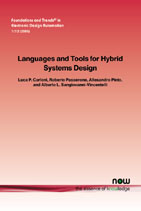Languages And Tools For Hybrid Systems Design
Languages and Tools for Hybrid Systems Design
By Luca P. Carloni, Department of Computer Science, Columbia University, USA, luca@cs.columbia.edu | Roberto Passerone, Cadence Berkeley Laboratories, 1995 University Ave Suite 460, USA, robp@cadence.com | Alessandro Pinto, Department of EECS, University of California at Berkeley, USA, pinto@eecs.berkeley.edu | Alberto L. Sangiovanni-Vincentelli, Department of EECS, University of California at Berkeley, USA, alberto@eecs.berkeley.edu
Suggested Citation
Luca P. Carloni, Roberto Passerone, Alessandro Pinto and Alberto L. Sangiovanni-Vincentelli (2006), "Languages and Tools for Hybrid Systems Design", Foundations and Trends® in Electronic Design Automation: Vol. 1: No. 1–2, pp 1-193. http://dx.doi.org/10.1561/1000000001
Publication Date: 30 Jun 2006
© 2006 L.P. Carloni, R. Passerone, A. Pinto, A.L. Sangiovanni-Vincentelli
Subjects
Free Preview:
Download extract
Share
Journal details
Abstract
The explosive growth of embedded electronics is bringing information and control systems of increasing complexity to every aspects of our lives. The most challenging designs are safety-critical systems, such as transportation systems (e.g., airplanes, cars, and trains), industrial plants and health care monitoring. The difficulties reside in accommodating constraints both on functionality and implementation. The correct behavior must be guaranteed under diverse states of the environment and potential failures; implementation has to meet cost, size, and power consumption requirements. The design is therefore subject to extensive mathematical analysis and simulation. However, traditional models of information systems do not interface well to the continuous evolving nature of the environment in which these devices operate. Thus, in practice, different mathematical representations have to be mixed to analyze the overall behavior of the system. Hybrid systems are a particular class of mixed models that focus on the combination of discrete and continuous subsystems. There is a wealth of tools and languages that have been proposed over the years to handle hybrid systems. However, each tool makes different assumptions on the environment, resulting in somewhat different notions of hybrid system. This makes it difficult to share information among tools. Thus, the community cannot maximally leverage the substantial amount of work that has been directed to this important topic. In this paper, we review and compare hybrid system tools by highlighting their differences in terms of their underlying semantics, expressive power and mathematical mechanisms. We conclude our review with a comparative summary, which suggests the need for a unifying approach to hybrid systems design. As a step in this direction, we make the case for a semantic-aware interchange format, which would enable the use of joint techniques, make a formal comparison between different approaches possible, and facilitate exporting and importing design representations.
DOI:10.1561/1000000001
Book details
Table of contents:
1 Introduction
2 Foundations
3 Tools for Simulation
4 Tools for Formal Verification
5 Comparative Summary
6 The Future: Towards the Development of a Standard Interchange Format
Languages and Tools for Hybrid Systems Design
Languages and Tools for Hybrid Systems Design is a survey of languages and tools for the design and verification of hybrid systems. The book reviews and compares hybrid system tools by highlighting their differences in terms of their underlying semantics, expressive power and mathematical mechanisms. The review concludes with a comparative summary, which suggests the need for a unifying approach to hybrid systems design. As a step in this direction, the case is made for a semantic-aware interchange format, which would enable the use of joint techniques, make a formal comparison between different approaches possible, and facilitate exporting and importing design representations. Languages and Tools for Hybrid Systems Design is also intended to equip researchers, application developers and managers with key references and resource material for the successful development of hybrid systems.

Languages And Tools For Hybrid Systems Design
Source: https://www.nowpublishers.com/article/Details/EDA-001
Posted by: ingramfaies1970.blogspot.com

0 Response to "Languages And Tools For Hybrid Systems Design"
Post a Comment